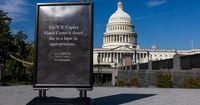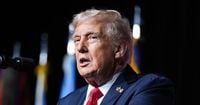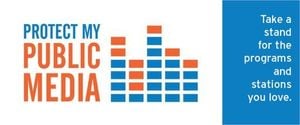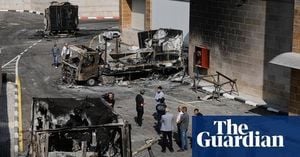In the early hours of October 1, 2025, the United States government ground to a halt, triggering a wave of uncertainty and anger across New York. With the Statue of Liberty looming in the background, Governor Kathy Hochul and a host of state officials gathered in lower Manhattan to voice their outrage, laying the blame for the shutdown squarely at the feet of President Donald Trump and Congressional Republicans. The scene was tense, charged with frustration over what many described as a deliberate political maneuver that would have far-reaching consequences for millions of New Yorkers.
"This shutdown is a choice, a deliberate decision by Donald Trump and the Republicans to abandon the very people they were sent to Washington to represent," Hochul declared, according to the New York Times. "And they alone are responsible for this." Her words echoed the broader sentiment among state leaders, who argued that the shutdown was not an unavoidable crisis, but rather the result of partisan brinkmanship and failed negotiations in Washington.
At the heart of the standoff was a bitter dispute over health care funding. Democrats, led by Senate Minority Leader Chuck Schumer and House Minority Leader Hakeem Jeffries, insisted that any stopgap measure to keep the government open must include an extension of enhanced Affordable Care Act (Obamacare) premium subsidies. These subsidies, set to expire in December, have helped millions afford health insurance. Democrats also pushed to restore $1 trillion in Medicaid spending that had been slashed as part of Trump’s July spending bill—funding that, in part, benefits immigrants with legal status. Republicans, on the other hand, accused Democrats of trying to funnel money to undocumented immigrants, a claim state officials flatly rejected as false.
Instead, House Republicans passed a so-called "clean" continuing resolution, proposing to keep the government running for another seven weeks without any changes to spending levels. The measure failed in the Senate, falling short of the 60 votes needed to overcome a filibuster. With both sides entrenched, the government shut down, leaving hundreds of thousands of federal workers—including more than 100,000 in New York—furloughed or forced to work without pay. Essential services, from air traffic control to national park operations, were thrown into chaos.
The shutdown’s impact on New York was immediate and severe. According to Gothamist, critical safety net programs like SNAP and WIC faced imminent funding shortfalls, threatening food security for millions. Hospitals braced for delays in federal reimbursements, while families reliant on housing vouchers or public housing worried whether their rent would be paid. The state’s health system, already reeling from previous federal cuts, risked losing $8 billion annually, and hospitals faced over $3 billion in uncompensated care costs. The loss of SNAP benefits alone threatened an $11 billion blow to New York’s economy, including its vital agriculture and food industries.
Governor Hochul did not mince words in her criticism of the shutdown’s architects. "After voting to gut food assistance and healthcare for millions of New Yorkers, Republicans in Congress – including seven members from New York – are once again recklessly siding with Donald Trump to shut down the federal government," she said, as reported by City & State New York. "The GOP shutdown will have devastating effects on workers, small businesses and families throughout our state. Washington Republicans need to do their damn jobs, actually stand up for the people they serve, and come to the table to end this shutdown."
The pain was not limited to program beneficiaries. Mario Cilento, president of the New York State AFL-CIO, highlighted the plight of public employees. "What our leaders have done by raising that benefit that goes into effect today – today! – is … giving (people) peace of mind throughout all this chaos that has been caused by every single Republican in Washington," he said, referencing a 70% increase in state unemployment benefits, from $504 to $869 per week, effective October 2. Yet for the more than 115,000 federal workers in New York, the prospect of missed paychecks loomed large, with many unsure how they would make ends meet.
State Attorney General Letitia James announced that her office had filed an emergency lawsuit over a sudden $33 million cut in Department of Homeland Security funds intended for Metropolitan Transportation Authority counterterrorism efforts. "I can think of no other state that is facing the risk than New York," she said. "Why did they zero it out? They zeroed it out because they allege that we're a sanctuary city." Meanwhile, the Trump administration froze $18 billion in infrastructure funds for the Gateway Project and the Second Avenue Subway, citing objections to New York’s diversity, equity, and inclusion (DEI) policies—specifically, requirements that a portion of contracts go to women- and minority-owned businesses.
As if that weren’t enough, an additional $187 million in expected cuts from the Department of Homeland Security to state and local law enforcement agencies for counterterrorism was only temporarily halted by a federal judge’s restraining order. The sense of crisis deepened with each passing hour, as state leaders scrambled to respond to a cascade of federal funding losses.
The political blame game raged on. Republicans labeled the crisis the “Schumer shutdown,” pointing to Democratic resistance in the Senate. The White House even set up an online shutdown clock, placing responsibility squarely on Democrats. But Hochul and her allies rejected this narrative, pointing out that Republicans controlled the presidency and both chambers of Congress. "They hold all the levers of power," Hochul said, highlighting Trump’s boast that his administration could make "irreversible" changes during a shutdown, such as slashing the federal workforce and cutting key programs.
State lawmakers and union leaders were quick to join the chorus of condemnation. Senate Majority Leader Andrea Stewart-Cousins called the shutdown "the direct result of ongoing chaos in Washington and a lack of leadership," warning of its "rippling effect" on workers, seniors, and veterans. Senator Toby Ann Stavisky lamented, "President Trump, meanwhile, is more concerned with escalators, fake science, and Jimmy Kimmel more than the millions of New Yorkers about to lose their healthcare and SNAP benefits." Across the board, officials described the shutdown as reckless, cruel, and a betrayal of working families.
Despite the grim outlook, state leaders pledged to do what they could to cushion the blow. Hochul pointed to inflation rebate checks arriving in October and November, expanded Child Tax Credit, free school meals, and expanded tax cuts for working people as measures to help New Yorkers weather the storm. "Here in New York, we're going to take care of you," Cilento said, reflecting a resolve that, even in the face of federal dysfunction, the state would stand by its residents.
Yet the uncertainty remains thick in the air. With vital programs hanging by a thread and negotiations in Washington stalled, New Yorkers are left to wonder how long the shutdown will last—and how much more damage it might inflict before the impasse is finally broken.
For now, the Statue of Liberty stands watch over a city—and a state—grappling with the real-world consequences of political gridlock. The message from New York’s leaders is clear: the stakes are high, the pain is real, and the fight to protect the most vulnerable is just beginning.





